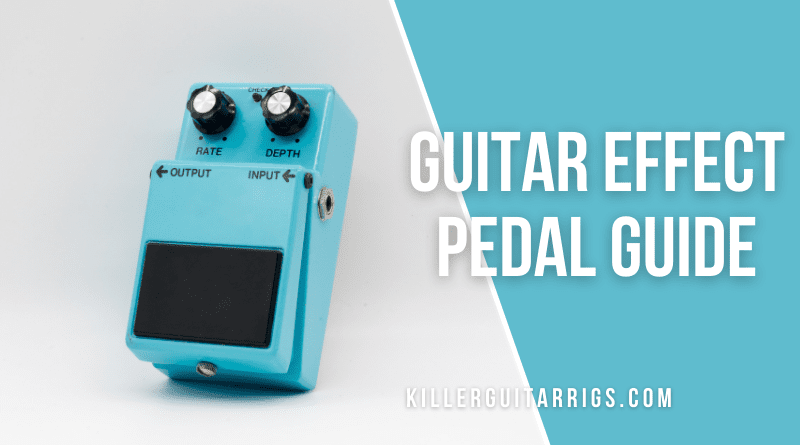Led Zeppelin’s Jimmy Page once said, “I believe every guitar player inherently has something unique about their playing.”
This is true on many different levels. When we play guitar, we unknowingly share an extension of our personality with others. But sometimes playing the guitar through just an amp does not quite cut it. We need some effect pedals to add more definition and color to our sound.
If you are curious about effects pedals, then here is our extensive guide on what they are, which ones you probably need, and how they can elevate your sound to the next level:
Contents
Guitar Effects Formats
Apart from pedals, also known as stompboxes, guitar effects also come in many different forms. They vary in terms of price and size. Different musicians prefer different formats based on their needs. Here are some of the most common ones:
Stomp Boxes
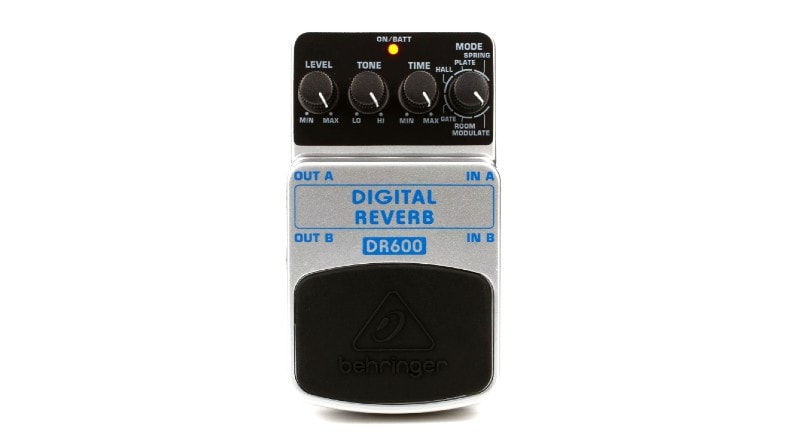
When people think of guitar effects, they usually think of stompboxes. These are placed in between the guitar and the amp. One can set up multiple pedals by daisy-chaining them, but we will get into the details of that later in this article.
Pedals are known as “stompboxes” because they hold the circuitry in a metal or plastic box. They need to be activated by stomping on the footswitch. One can toggle the pedal on or off by pressing the footswitch. Stompboxes remain the most popular type of guitar effects.
While a majority of them are rectangular, an exception is Dunlop’s Fuzzface series, which is circular in shape. They can be of different sizes. Mini pedals such as the TC Electronic Polytune Mini are roughly 2.3*4.3 inches. Standard size pedals such as the Boss TU-3 Chromatic Tuner are 2.87*5 inches. There are also larger pedals available such as the Strymon NightSky or even BlueSky, which take up more room in a setup and have a lot more controllable parameters.
Rack Effects
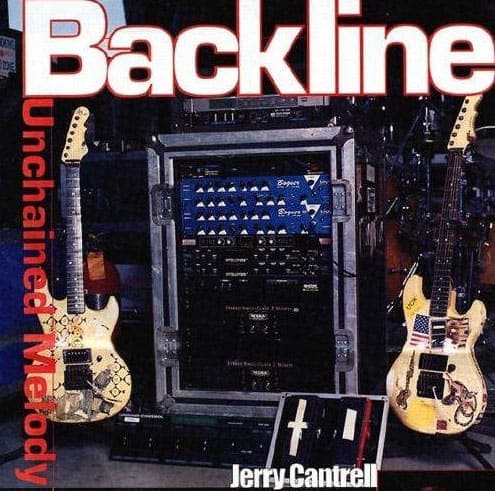
Rackmount effects are generally found in a home or professional studio setup since they are not as portable as pedals. A typical rack is usually 1.75” tall and 19” wide.
These offer a higher quality of sound and many have multiple effects and extensive controls to tweak the parameters.
One of the main reasons rack effects are popular is because they can be controlled via MIDI and thus one can make different micro-adjustments to the sound. These can then be saved and recalled later.
Many touring musicians prefer carrying rack effects since these emulate amp and cabinet configurations. This means they can replicate the ideal sound without being dependent on the venue and the backline. Fractal Audio Systems’ Axe FX is a commonly used rack effect.
Multi FX
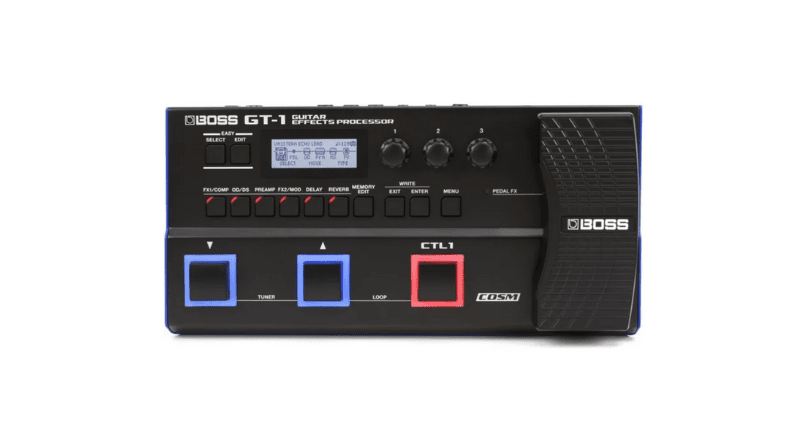
A multi-fx unit contains many different kinds of digital effects and is commonly used by guitar players who do not want an elaborate pedal setup. Some of them, such as the Line 6 Helix can also be used as an amp modeler.
Multi FX processors usually have multiple footswitches and effects presets which can be tweaked as per preference.
In terms of size, they vary. While Eventide’s H9 is more compact, others such as the Boss GT-1000 or the Mooer GE200 can be bulky and need special cases to prevent damage during travel.
Built-In FX
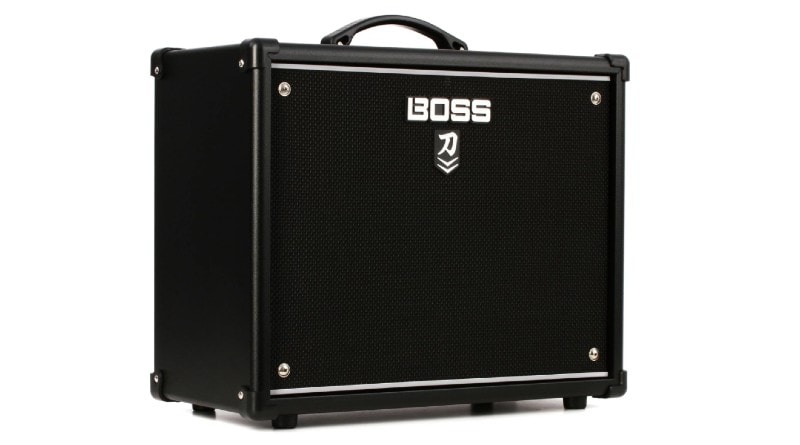
You may have noticed that your electric guitar has different knobs to adjust the sound of the different pickups. Similarly, your amp too will have knobs such as ‘volume’, ‘treble’, ‘mid’, ‘bass’ etc, to define your sound.
Additionally, some amps also have built-in effects ranging from delay and reverb to more complex ones such as chorus, tremolo, and even distortion. These are known as modeling amps.
The Boss Katana 50 MKII is a very popular modeling amp.
Check out our picks for the best modeling amps.
Major Effect Types
Whether you want to add slight color to your tone and make it stand out or turn your guitar into a whole new instrument, effects can be of many different kinds. Effects are typically broken into seven major buckets, which are filter, compressor, gain, pitch, modulation, volume, and time. Let us take a look at them in detail:
1. Filter
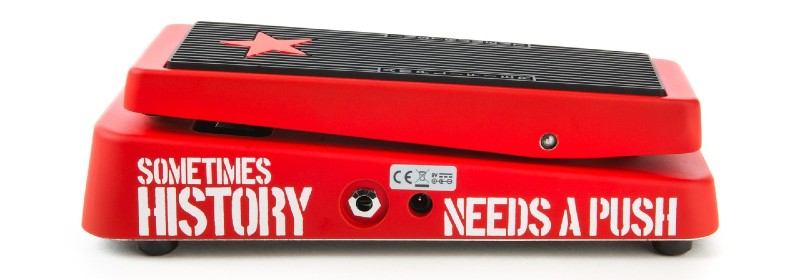
A filter is used to amplify or reduce certain frequencies in the sound. They usually operate in the audio frequency range of 0Kz to 20kHz. Filters can be of four different types.
A low-pass filter progressively attenuates frequencies that are set above the cutoff. These are used to filter noise from a circuit.
A high-pass filter passes the frequencies above the limit and progressively attenuates those below the cutoff.
A bandpass filter has two cutoffs and passes the frequencies between them and attenuates those outside the range.
An all-pass filter passes all frequencies but affects the phase. A phaser pedal uses this principle.
Some of the most common filter effects found in pedals are:
Wah-Wah
A wah-wah (or ‘wah’) pedal alters the frequency and tone of your guitar sound to emulate a human voice phonetically mimicking the word ‘wah-wah’. It does so by sweeping the peak response of a frequency up and down.
The effect is said to have originated in the 1920s from trumpet and trombone players. Today we get digital emulations of this effect in the form of pedals. The potentiometer in such pedals is controlled by rocking the foot back and forth.
Some of the most prominent ones wah-pedals manufactured are Dunlop’s Crybaby, Vox Wahs such as the V847A and V846, the Morley PWO Power Wah, etc.
The wah-wah effect can be heard extensively in Jimi Hendrix’s music, in songs such as Voodoo Chile. ‘Bad Horsie’ by Steve Vai is another prominent song with wah-wah and led to the eventual release of his signature wah pedal with the same name, in collaboration with Morley.
Equalizer
An Equalizer or EQ pedal helps you shape and fine-tune the frequency spectrum of your sound by boosting or reducing certain frequencies. They are used by both guitar and bass players.
While most pedals have the same basic function, they are broadly categorized into two main categories: graphic and parametric EQs. The Boss GE-7 is a graphic EQ pedal whereas EarthQuaker Devices’ Tone Job is a parametric one.
The placement of the EQ on the signal chain can be a crucial part of defining one’s sound. But more on that later.
Envelope Filters
Envelope filter pedals are used to add an element of funk to one’s sound. What makes them unique is that they are controlled by the dynamics of one’s playing. The louder we play, the more intense the effect gets. This is because they are controlled by the level of input signal fed into them.
Jerry Garcia as well as Booty Collins used an envelope filter in many of their songs. It can be heard on Grateful Dead’s Shakedown Street and Parliament’s Wizard Of Finance. In a more modern context, Radiohead’s Ed O’Brien uses an envelope filter on Talk Show Host and Paranoid Android.
Electro Harmonix’s Q-Tron, Mojo Hand Fx’s Wonder Filter, and the Pigtronix Envelope Filter are examples of some commonly used pedals for guitar and often even bass.
Talk Box
A talk box (one of our favorite weird pedals) directs the sound from a guitar into a musician’s mouth through a tube adjacent to a microphone. This results in an instrument/voice hybrid sound as the performer changes the shape of their mouth or placement of their tongue.
The talkbox pedal can be heard on Bon Jovi’s Living On A Prayer, Steely Dan’s Haitian Divorce, Nazareth’s Hair Of The Dog, and Aerosmith’s Sweet Emotion.
Although the concept of the talkbox is credited to Alvino Rey (in 1939), the first high-powered talkbox was invented by Bob Heil and can be heard in the song Rocky Mountain Way by Joe Walsh.
In 1988 Heil sold the manufacturing rights of his talkbox pedal to Dunlop, who continued to produce them with the same specifics of the original developed in 1973.
Currently, some of the most prominent talkbox pedals are MXR’s M222 Talk Box, the TC Helicon TalkBox Synth, and the Dunlop Heil Talkbox HT-1.
2. Compressor
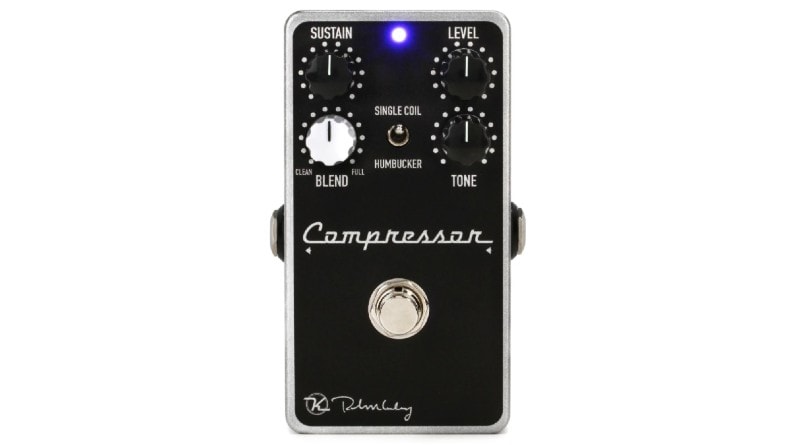
When we sing, we tend to vocalize certain parts louder than others. Sometimes we may also whisper a section of a song. While the dynamics help us emote our feelings, it can be often tricky to record a signal with too many peaks and troughs. The same is applicable for instruments as well. If a signal is too loud, it can clip. If a signal is too soft then it will be inaudible. A compressor helps prevent either situation.
A compressor evens out the dynamics by boosting quieter parts or restricting louder parts. This makes the overall output sound smooth and audible without distortions.
A compressor pedal has many uses. You can use one to give your clean tone a boost without adjusting the overall volume. If you play treble-heavy genres such as funk or country music, a compressor can be used to amplify the high-end frequencies of your sound. You can also use one to add more sustain to lead guitar parts so they stand out from the rest of the elements of the music.
The MXR Dyna Comp pedal has been used by the likes of John Frusciante, Noel Gallagher, Eric Johnson, and even The Edge. Artists such as Tosin Abasi, Brad Paisley, and Wayne Sermon use the Wampler Ego. Other popular compressor pedals include, but are not limited to, Empress Effects’ Analog Compressor, Mooer’s Yellow Compressor, and Keeley’s Compressor Plus.
3. Gain
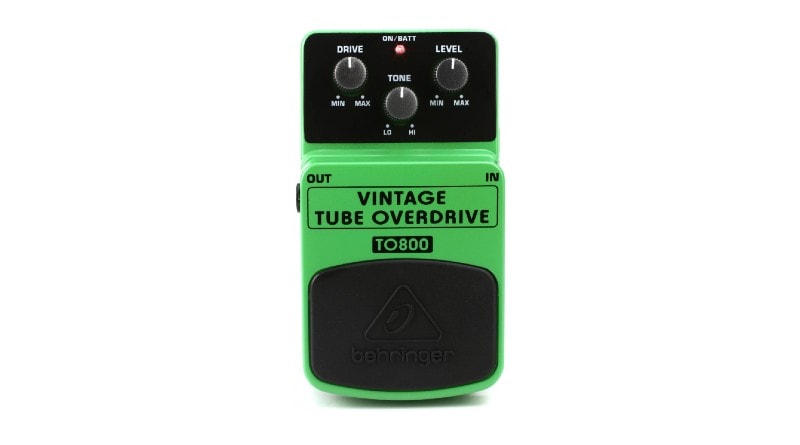
Gain is used to control the input volume from the guitar to the amplifier. When the gain is set to a high level it often leads to a distortion in the tone, perfect for heavier genres of music. The main types of gain pedals are:
Overdrive (Drive)
Overdrive tones are synonymous with almost all genres of rock music. But what exactly is ‘overdrive’?
When a tube amp is pushed to its limit, it produces a highly saturated sound. This is known as an “overdrive”. Since most guitar players do not want to deafen themselves and their audience, they use stompboxes that can recreate this tone even at low volumes.
Since overdrive pedals produce a soft clipping, they are ideal for adding a crunch to the tone. While Ibanez’s Tube Screamer Mini is a compact pedal packing a punch, the Mesa Boogie Flux Five Overdrive is a bigger stompbox offering additional features. You’ll also hear about pedals such as the mythical Klon Centaur being “transparent”, which essentially means you get your crunch without any additional EQ changes.
Fuzz
Fuzz pedals turn the audio signal from a guitar into a square wave. This results in large amounts of harmonic saturation from the extreme clipping.
A fuzz became extremely popular after Jimi Hendrix used a Dallas Arbiter Fuzz Face in songs such as Purple Haze. A fuzz can also be heard quite prominently on Are You Gonna Go My Way by Lenny Kravitz, Blue Orchid by The White Stripes, and The Smashing Pumpkins’ Siamese Dream.
Electro Harmonix’s Big Muff Pi, Dunlop’s Mini Germanium Fuzz Face, and Voodoo Lab’s Superfuzz are highly recommended by guitar players.
Distortion
While an overdrive pedal produces a soft clipping of the audio signal, distortion pedals are used for a more aggressive clipping of the input sound. This is because a large amount of gain is added, thus pushing the audio signal beyond its peak.
Distortion is used for heavier genres of music such as grunge, hard rock, and most of the sub-genres of metal. Kurt Cobain (Nirvana) played the Boss DS-1 on the albums Bleach and Nevermind.
However a distortion can be versatile when used innovatively. Pro Co’s RAT distortion pedal can be heard on Blur by Blur, The Bends by Radiohead (Johnny Greenwood), and Monster by R.E.M.
4. Pitch
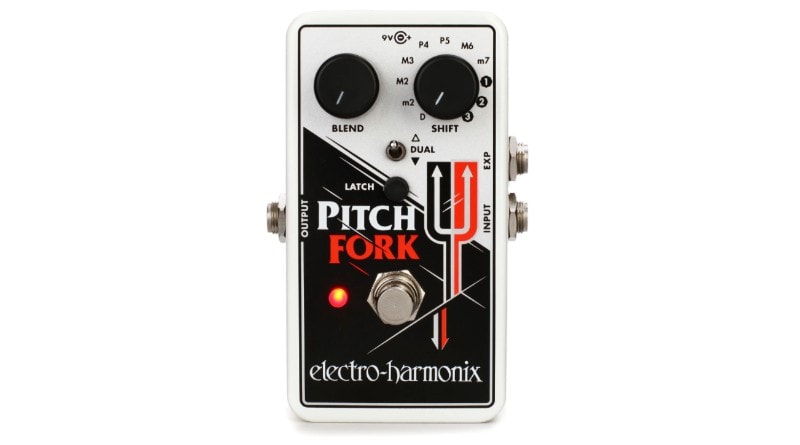
The position of a single sound in an entire range is known as “pitch”. Pedals such as pitch shifters, octavers, whammies, and harmonizers create harmonies out of a single audio input.
A pitch shifter raises or lowers the pitch of the original sound. This is determined by a preset interval.
An octave pedal blends the original signal with the audio that is higher or lower in octave.
A harmonizer adds the pitch-shifted audio to the original to create a two-note (or more) harmony (check out our picks of the best harmonizer pedals).
While some guitars have whammy bars, their function is often limited. A whammy pedal has a greater pitch range and can function as a pitch shifter as well as a harmonizer.
Examples of pitch shifts in music include the main riff of Seven Nation Army by The White Stripes, which is a guitar part emulating the sound of a bass. Rage Against The Machine’s Killing In The Name, and Joe Satriani’s Searching also feature pitch-shift.
Electro Harmonix’s Pitch Fork is an example of a pitch shifter, whereas the Mooer Pure Octave is an Octaver pedal and the TC Electronic Quintessence is a harmonizer. Digitech’s DT Whammy can be heard on Audioslave’s Like A Stone, Touching Tongues by Steve Vai, and Becoming by Pantera.
5. Modulation
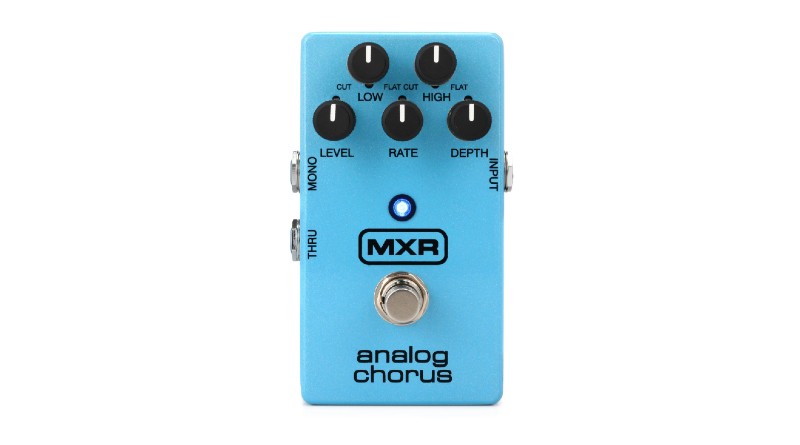
Modulation pedals can be of many different kinds. While some are used to manipulate the pitch, others can be used to split the signal and add effects to it. The main categories of modulation pedals are:
Chorus
A chorus pedal splits the input audio signal into multiple “voices” and different pitch and timbre modulations are added to these clones. These are then joined back to the original sound. The result is the effect of multiple guitars playing simultaneously.
The chorus was widely used in the Eighties and can be heard in Bryan Adams’ Run To You, Boston’s More Than A Feeling, and in songs from Regatta De Blanc by The Police. It was also used for the opening riff of Nirvana’s Come As You Are and Soundgarden’s Black Hole Sun.
The Boss MD-500 is a mammoth chorus pedal offering many patch customizations whereas TC Electronic’s Corona Chorus and Electro Harmonix’s Neo Clone are more compact ones.
Flanger
A flanger pedal splits the audio signal into two. While one is clean, the other has a short but gradually changing delay added to it. This gives the sound a comb filter effect.
The wobbly-sounding riff in Heart’s Barracuda is the result of a flanger. One of the earliest examples of a flanger is the Beatles’ Tomorrow Never Knows from their album Revolver.
A flanger is a staple on the pedalboards of many famous guitar players. MXR’s EVH117 is Eddie Van Halen’s signature pedal. John Petrucci (Dream Theater) uses the TC Electronic Dreamscape. Both Mark Hosking (Karnivool) and Billy Duffy (The Clash) have used the Boss BF-2 flanger extensively in their music.
Phaser
A phase shifter, or phaser, emulates the sound of a rotating organ. This creates a “swirling sound”.
The phaser can be heard on Kashmir by Led Zeppelin, the solo section of Don’t Stop Me Now and We Will Rock You by Queen, and on the album Morning View by Incubus.
Some of the most trustworthy phaser pedals include, but are not limited to, MXR’s Phase 95, Source Audio’s Lunar Phaser, and Boss’ PH-3 Phase Shift.
Tremolo
A tremolo pedal changes the volume of the input audio signal, but only at certain frequencies. One can set different depths and speeds of the modulation.
A tremolo is often confused with a whammy, but unlike the latter, a tremolo does not change the pitch of the original audio.
From Otis Redding’s A Change Is Gonna Come to Radiohead’s Bones, a tremolo has been used in various genres of music. Other examples include the iconic intros of How Soon Is Now by The Smiths and Rolling Stones’ Gimme Shelter.
While the Boss TR-2 Tremolo pedal is a great one for beginners, Wampler’s Latitude Deluxe V2 has more parameters that can be tweaked according to preference.
6. Volume And Expression
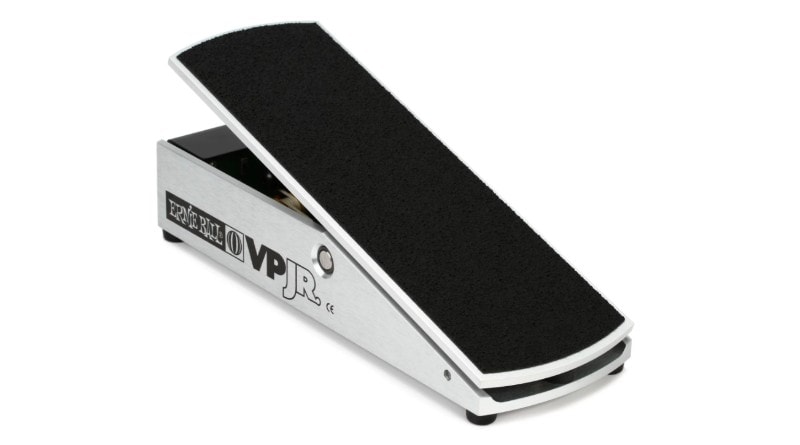
Volume pedals can be used to completely mute your sound, create swells, or even control your dynamics through the song. These come in the form of ‘treadle’ style foot pedals.
Since it would be a little bit redundant to have a pedal just for volume, many guitar players use an expression pedal.
An expression pedal is a treadle-type pedal that can be used to control parameters such as volume, modulation, and even delay.
While pedals such as Ernie Ball’s MVP and Boss’ FV-500H can be used as dedicated volume pedals, Moog’s EP-3 and Nektar’s NX-P can be used to control many other parameters.
But if you are looking to add a certain extra punch to your tone, you can use a boost pedal.
A boost pedal increases the gain of the guitar signal without majorly affecting the tone. This means that when the signal is sent to the preamp of an amp, there is an increase in the signal level without any change in the tone.
Boost pedals come in two types – a clean boost pedal will increase the signal without adding any color to the tone, whereas a dirty boost pedal (often just referred to as a boost pedal) will add a little color or compression to your signal.
For example, if you are using a fuzz pedal you will notice that setting the output tone to a maximum will often result in a loss of body in the tone. This is when a boost pedal can come in very handy. You can also use one to add depth to clean tones, which may otherwise get lost in the mix.
Electro Harmonix’s Linear Power Booster LPB-1 Nano is a compact and easy-to-use boost, whereas pedals like the J. Rockett Archer can also double as an overdrive.
7. Time
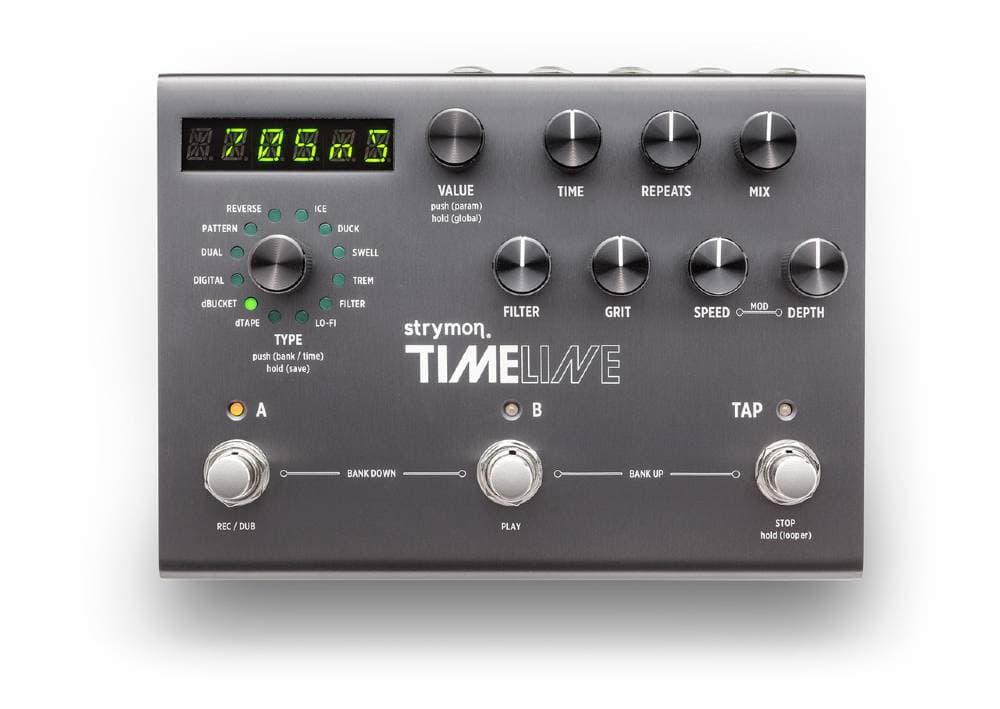
Echoes, reverbs, and delays are all considered time-based effects since they manipulate the signal’s timing in different ways.
While it is often easy to get confused between the three, you can read about the difference between echo and delay here, as well as the difference between reverb and delay here.
Surf music such as the cover of Misirlou by Dick Dale uses reverb extensively for the guitar tone associated with the genre. The Behringer DR-600 Reverb and EX Digital Reverb Pedal Mini are budget-friendly reverb pedals and great for beginners.
Delay pedals can be used in many different ways, from adding a subtle texture to one’s sound to even doubling the notes played. Guitar players such as David Gilmour and The Edge are credited for changing the way delays can be used in music. Pedals such as the Boss DD-3T Digital Delay, TC Electronic’s Flashback Delay, and MXR’s Carbon Copy are all budget-friendly and durable delay pedals available in the market today.
Pedal Order
Apart from knowing how every pedal works, it is also important to understand which order to place them in.
The most common signal chain placement from the guitar to the amp (or to a preamp pedal) is:
- Tuner
- Dynamics pedals (filters, compression, and equalizers)
- Gain pedals
- Modulation pedals
- Time-based pedals
- Volume and expression pedals.
The reason for arranging the pedals in this order is to ensure there is minimum noise (aside from using a noise gate) while still being able to extract the best-sounding tone from one’s setup. For example, if you put your compressor after your EQ pedal, you can end up compressing noise, as EQ pedals tend to add a little noise to your chain.
Although this is the most common method, guitar players often like to experiment with the order for unique results best suited for the music they play. A common variation is placing the volume and expression pedals before the time-based pedals such as delay and reverb.
If you are using an effects loop from the amp or a loop pedal, you can either place them before or after the time-based pedals based on the kind of sound you are looking for. We will elaborate on that later in this article.
Pedal Power
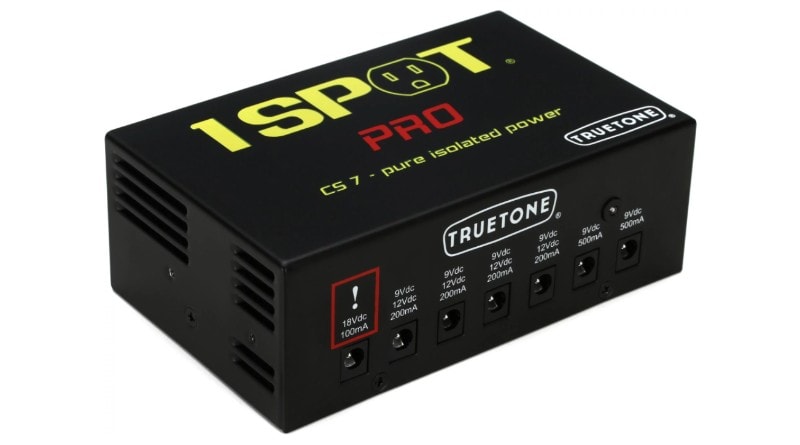
Different pedals need different voltages such as 9V, 12V, 18V, or 24V to work.
While some pedals run on batteries such as a 9V or an external power source, others need a dedicated power supply to work.
Batteries are unreliable because pedals may drain them very quickly and without warning. This is because even they are not in use, pedals might still use some battery when they are in the casing and connected to the pedal.
Even though 9V is often the standard, manufacturers always state explicitly when a particular pedal requires a higher voltage. It is important to be mindful of this requirement when plugging your pedal into a power source, otherwise, it may short-circuit.
Certain pedals may also require an isolated power unit because they can drain your power supply or cause unwanted noise.
Although it can seem like quite an investment initially, it is always good to get hold of a dedicated power supply to save yourself from the hassle of powering different pedals using multiple adapters. A power brick or a power supply unit can be used to power multiple pedals at the same time. While some may have fixed voltages, others may have the option to switch the voltage or current output.
While T-Rex’s Fuel Tank is ideal for those with many different pedals, the Ernie Ball Volt is more compact.
Pedal Boards
If you want to set up a signal chain with multiple pedals, it would be impractical to set them up in a straight line and use individual power sources for each. Not only would you occupy a lot of space, but it would also take you a long time to set up. This is when a pedalboard can come in handy and save you the headache of setting up your pedals individually.
Pedalboards are essentially flat surfaces made of wood, plastic, or metal which can be used as a container or patch bay for all your pedals. They help you manage your pedals and double as a means of transportation for them. Pedalboards can be custom-made or store-bought. They vary in size, depending on the number of pedals one needs to accommodate on them.
While some pedalboards have built-in power supplies, many guitar players use an external isolated power supply unit such as the Voodoo Lab Pedal Power to daisy-chain their pedals even though they may have different voltage requirements.
A daisy chain is plugging multiple pedals into the same power unit.
Although daisy-chaining is a common method, the signals go through pedals that may not be connected or required. This often leads to corruption in the tone. Pedal switchers such as the GigRig’s G2, G3, and Voodoo Lab’s Pedal Switcher offer true bypass and only send the audio signal to the pedals in use. These can be added to the pedalboard.
Pedalboards (including your pedals and their connecting patch cables) can be carried around in soft cases with padding or even on hard flight cases. This makes them easy to transport.
Placement: Front Of Amp Vs Effects Loop
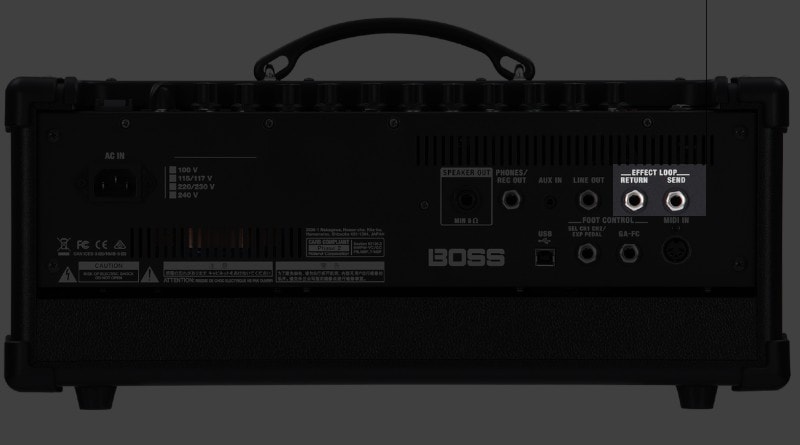
If you have a fairly simple setup and need the amp to merely give you an output sound through a clean channel, then you can place all your pedals before the amp. While this is the most uncomplicated method, you might run into problems if you use reverb or a delay but also want to add some overdrive from the amp. An added layer of gain after time-based effects can often make the tone sound muddy and unclear. In such instances, you can set up your pedals is by placing them within an effects loop of your amp if it has one.
An effects loop refers to the audio input and output loop that is created after the preamp and before the poweramp of your amp, using the ‘send’ and ‘return’ effects jacks.
An effects loop can be of two different kinds: series and parallel.
In a series effects loop, the audio signal is routed from the preamp to the effects section and then to the poweramp. The process is simple and linear.
In a parallel effects loop, the audio signal is split into two paths. While one is connected to the poweramp from the preamp without any interference, the other is routed from the preamp to the effects processor and then to the poweramp. Parallel effects loops can be created using certain amps which offer a variable mix knob to blend the two signals. One can thus mix the signals and control how much effect is added to the output tone.
Although this is a cumbersome method, parallel loops are used to avoid loss of sound quality when using high-noise pedals.
The 4 Cable Method
If you are using the effects from an amp along with your pedals, the ideal way to set up your signal chain would be through the ‘4 cable method’.
While all amps have an input, there are some with an effects loop, as explained in the earlier sections. This means that there is a ‘send’ and ‘return’ within its circuit. Plugging the guitar into the input of the amp and running it through its effects loop makes a difference in the tone. While you may want to plug gain or modulation pedals before the effects loop of the amp, time-based pedals work best when they are connected after the signal passes the amp’s effects loop.
The 4 cable method (4CM) allows you to set up some pedals before the preamp and others after the effects loop of the amp. This is done by using 4 cables, hence the nomenclature.
Here is how to set up a basic rig using 4CM:
- Cable 1: connect your guitar to the pedals you want to run before the amp.
- Cable 2: connect this group of pedals into the amp.
- Cable 3: connect the ‘send’ from the amp’s effects loops to the next group of pedals.
- Cable 4: connect the next group of pedals to the ‘return’ of the amp’s effects loop.
If you are using a multi-effects processor, here’s how to set up 4CM:
- Cable 1: connect your guitar to your multi-effects processor.
- Cable 2: connect the ‘send’ from the unit to the amp’s input.
- Cable 3: connect the ‘send’ from the amp’s effects loop to ‘return’ of your multi-effects processor.
- Cable 4: connect the output of the unit to the amp’s ‘return’.
This process is also applicable when using rack-mounted effects.
Guitar Pedals and Effects: Glossary
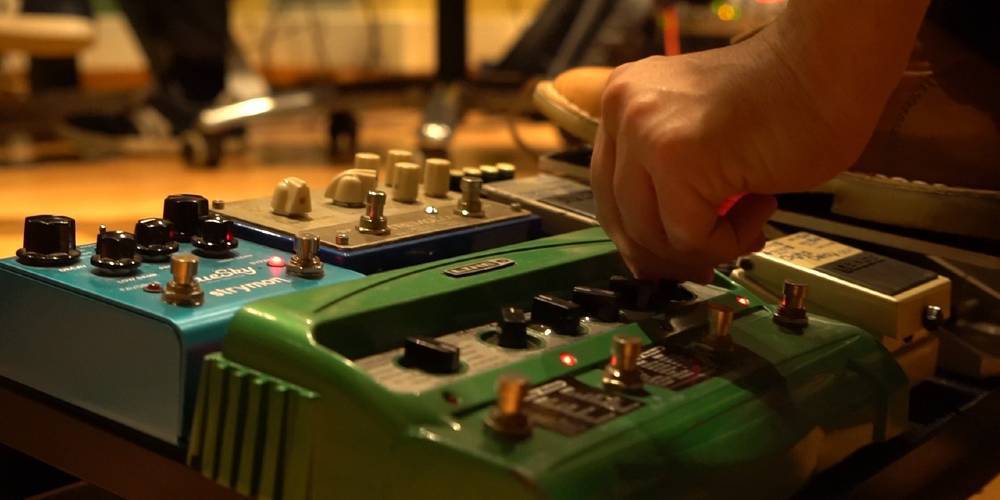
Whether your guitar-player friends casually drop some of these terms in their conversations or words that you may find on your pedals, here are some commonly used terms and what they mean:
- Dry/Wet: This refers to the amount of effect that is added to the input signal. For example, when you are using a delay pedal, the wetter you set it, the more the delay that is added to your tone. If it is dry, then a minimal delay is added to your tone. Think of this as the minimum and maximum where wet is maximum on the scale.
- True bypass: This refers to a switching circuit in the pedal that routes the audio signal directly from the input to the output when switched off. This results in no distortion or loss in the tone.
- BBD: A ‘bucket brigade device’ is found mostly in analog circuits. It is a small chip that delays an incoming signal. These are found most commonly in analog delay pedals.
- Tap Tempo: this indicates your pedal (delay, tremolo etc) has a function that allows you to manually enter or set the time/rate for the effect. When buying a delay pedal, many people will specifically seek out a tap tempo delay pedal, as this makes it much easier to get in sync with your drummer when there’s no click being used.
- Gain Stacking: When you use multiple gain-based effects such as drive, fuzz, and distortion in your signal chain, this is known as gain-stacking. The goal is to achieve the perfectly crafted tone in lower volumes without heavy corruption. Not just your pedals, but gain stacking also includes how you set the controls on your amp.
- Patch Cable: An electrical or optical cable used to connect two different cables in a signal chain. These are significantly shorter in length than regular instrument cables and go from the output of pedal 1 to the input of pedal 2 in a chain.
- Boutique Pedal: While we have been mentioning many different brands, these are all large-scale manufacturers of guitar pedals. Boutique pedals are designed and manufactured by smaller companies and often have limited production. While these can be a lot more expensive, they offer premium quality in terms of sound. If you are feeling adventurous, you should look up boutique pedal companies near you because sometimes they can also design and produce custom effects pedals.
- Analog: Analog pedals comprise circuits that run continuous signals passing through them. This results in the tone sounding “warmer” and the difference is most audible in time-based pedals. Although they may be harder to control, the guitar tone sounds rich because there is no loss during conversion of the guitar output signal.
- Digital: Digital pedals use a Digital Signal Processing (DSP) chip to create the effect in your pedal. While this results in a tone that is not as ‘authentic-sounding as an analog pedal, the benefits are that there are a lot more parameters you can control.
Conclusion
The world of guitar effects can often seem intimidating when you are beginning your journey, but do not worry. All guitar players tend to feel the same way. A piece of advice all professionals will give you is that prioritize which pedals are necessary and make a wishlist of the ones you would like to keep adding to your chain.
Although we haven’t spoken about tuner pedals in this article, that should be your first major purchase. A good tuner pedal will not only last a lifetime but also ensure you do not sound out of tune. Invest in a pedal rather than a clip-on tuner since they can often be unreliable in loud environments such as a gig.
The great thing about having a pedal-based setup is that you can slowly build your chain and thus there is no pressure. If you feel like you have outgrown a certain pedal on your board or no longer have any use for it, you can always upgrade or trade with a fellow musician!

